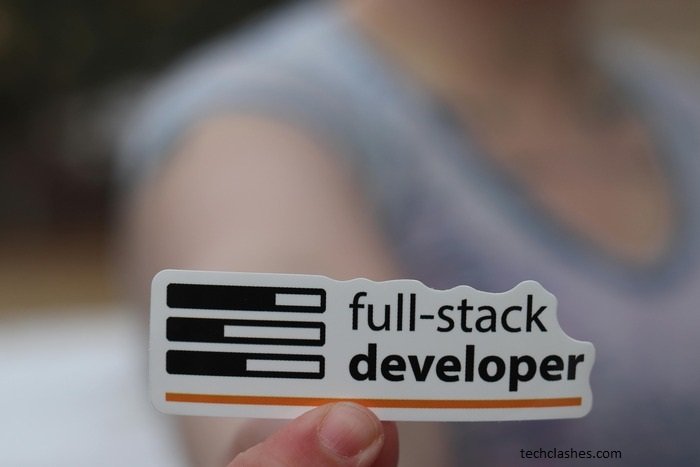Full Stack Development is a complete way to deal with making web applications that includes chipping away at both the front end and back finish of the application. A “stack” alludes to an assortment of innovations and instruments used to fabricate a product application. In full-stack advancement, engineers are capable in both client-side and server-side programming, permitting them to deal with all parts of an application from its UI to its data set.
Clients interface with straightforwardly the front finish of a web application. It incorporates components like the UI, plan, and usefulness. Front-end engineers normally work with dialects like HTML, CSS, and JavaScript to make responsive and intuitive connection points that give a consistent client experience across various gadgets and programs.
Then again, the back finish of a web application comprises the server, information base, and application rationale. Back-end designers are liable for building and keeping up with the server-side parts of an application, overseeing information stockpiling, and carrying out business rationale. They frequently work with advances like Node.js, Python, Ruby on Rails, PHP, and data sets like MySQL, MongoDB, or PostgreSQL.
Full stack engineers have the right stuff and information to deal with both the front end and back finish of an application, permitting them to take a task from origination to the end. They comprehend how various parts of a web application cooperate and can foster arrangements that meet both client needs and business necessities.
Notwithstanding specialized abilities, full-stack designers frequently have solid critical abilities to think, great relational abilities, and the capacity to function admirably in groups. They are versatile and equipped for learning new advances and apparatuses depending on the situation to stay aware of the quickly developing field of web improvement.
Skills Required for Full Stack Development
- Frontend Development
- Backend Development
- Database Management
- Version Control
- Web Architecture
(1) Frontend Development
Frontend improvement alludes to the act of building the UI and client experience of a site or web application. It includes making the visual components, design, and intuitive elements that clients collaborate with straightforwardly in their internet browsers. Frontend engineers utilize an assortment of programming dialects, systems, and devices to plan and execute these parts.
HTML (Hypertext Markup Language):
HTML is the standard markup language for making site pages. It gives the construction and content of a website page by characterizing components like headings, sections, connections, pictures, and structures.
CSS (Flowing Templates):
CSS is utilized to style and organize the visual show of HTML components. It permits engineers to control the format, varieties, textual styles, and other plant parts of a site page, guaranteeing a steady and outwardly engaging client experience across various gadgets and screen sizes.
JavaScript:
JavaScript is a programming language that empowers dynamic and intelligent conduct on site pages. Frontend engineers use JavaScript to add usefulness, for example, movements, client input approval, dynamic substance updates, and communication with outer APIs (Application Programming Connection points).
Notwithstanding these center advancements, frontend designers frequently use structures and libraries to smooth out the improvement interaction and upgrade the usefulness of their applications. Some well-known frontend systems and libraries include:
React.js: A JavaScript library for building UIs, created by Facebook. Respond permits designers to make reusable UI parts and deal with the condition of their applications proficiently.
Rakish: A web application structure created by Google. Precise gives an extensive answer for building dynamic single-page applications (SPAs) with highlights, for example, information restricting, directing, and reliance infusion.
Vue.js: A dynamic JavaScript system for building UIs. Vue.js is known for its effortlessness and adaptability, making it simple for engineers to incorporate into existing tasks or work without any preparation.
Frontend improvement requires imagination, tender loving care, and a decent comprehension of client experience standards. Front-end engineers work intimately with fashioners, back-end designers, and different partners to guarantee that the result meets both specialized prerequisites and client assumptions. They are likewise answerable for improving website pages for execution, openness, and web search tool permeability, to give the most ideal experience to clients.
(2) Backend Development
Backend improvement alludes to the most common way of building and keeping up with the server-side parts of a site or web application. While frontend improvement centers around the UI and client-side collaborations, backend advancement manages the server rationale, information base administration, and application usefulness that clients don’t straightforwardly have any idea yet are fundamental for the application to appropriately work.
Backend designers utilize an assortment of programming dialects, structures, and devices to make the server-side rationale and foundation expected to control web applications. A portion of the critical parts of backend improvement include:
Server-side programming dialects:
Backend engineers use dialects like Python, Java, Ruby, PHP, Node.js, and others to compose the code that sudden spikes in demand for the server. These dialects are utilized to deal with demands from the client, process information, and create reactions.
Systems and libraries:
Backend structures give pre-assembled parts and instruments to smooth out the advancement cycle and implement best practices. Models incorporate Django and Flagon for Python, Spring Boot for Java, Ruby on Rails for Ruby, Laravel for PHP, and Express.js for Node.js.
Data sets:
Backend engineers work with data sets to store, recover, and control information utilized by the application. They utilize social data sets like MySQL, PostgreSQL, and SQL Server, as well as NoSQL data sets like MongoDB, Redis, and Cassandra, contingent upon the particular prerequisites of the undertaking.
APIs (Application Programming Points of interaction):
Backend engineers plan and execute APIs to permit correspondence between various parts of the application or with outer administrations. APIs characterize the endpoints and information arranges that clients can use to cooperate with the server, empowering functionalities like client confirmation, information recovery, and coordination with outsider administrations.
Security:
Backend designers are liable for executing safety efforts to safeguard the application and its information from unapproved access, information breaks, and other security dangers. This incorporates rehearses like info approval, validation, approval, encryption, and executing secure correspondence conventions (e.g., HTTPS).
Backend improvement assumes an urgent part in guaranteeing the exhibition, versatility, and dependability of web applications. Backend engineers frequently work intimately with frontend designers, fashioners, and different partners to incorporate frontend and backend parts consistently and convey a strong client experience. They likewise screen and keep up with the server framework, improve information base inquiries, and investigate issues to guarantee that the application chugs along as expected and proficiently.
(3) Database Management
Data set administration alludes to the most common way of putting away, coordinating, and overseeing information in a data set framework. Information bases are essential parts of most programming applications, as they give an organized and effective method for putting away and recovering information.
Key parts of data set administration include:
Information base Plan:
This includes planning the construction of the data set, including characterizing tables, sections, connections, and requirements.
Information Demonstrating:
Information displaying includes distinguishing the elements, qualities, and connections that should be addressed in the data set. This step assists engineers with grasping the information necessities of the application and planning a proper data set diagram.
Information Base Creation and Setup:
When the data set plan is concluded, designers make the data set and arrange it as per the determinations. This incorporates setting up tables, characterizing information types, laying out connections among tables, and designing access controls and security settings.
Information Capacity and Recovery:
Data set administration frameworks (DBMS) give instruments for putting away and recovering information effectively. Engineers use SQL (Organized Question Language) or other inquiry dialects to perform tasks like embedding, refreshing, erasing, and questioning information in the data set.
Information Trustworthiness and Consistency:
Data set administration includes authorizing information uprightness requirements to keep up with the precision and consistency of the information. This incorporates characterizing essential keys, unfamiliar keys, extraordinary requirements, and different standards to guarantee that information stays substantial and steady after some time.
Ordering and Execution Enhancement:
To further develop execution, designers might make lists of segments much of the time utilized in questions, which permits the data set to rapidly recover information. Furthermore, engineers improve data set inquiries, Full Stack Development to adjust arrangement settings, and execute reserving instruments to upgrade execution and adaptability.
Reinforcement and Recuperation:
Data set administration incorporates carrying out methodologies for supporting information consistently and reestablishing it if there should arise an occurrence of information misfortune or defilement. This guarantees that basic information stays accessible and recoverable in case of equipment disappointments, programming mistakes, or other unanticipated conditions.
Security and Access Control:
Data set administration includes executing safety efforts to safeguard delicate information from unapproved access, altering, and burglary. This incorporates carrying out validation components, job-based admittance controls, encryption, Full Stack Development, and examining to guarantee that main approved clients can get to and adjust the information.
(4) Version Control
Rendition control, otherwise called source control or update control, is a framework that tracks changes to documents and catalogs over the long run. It permits various clients to team up on a venture, Full Stack Development tracks the historical backdrop of changes and oversees various variants of records productively.
Key parts of rendition control include:
Following Changes:
Rendition control frameworks (VCS) record each change made to documents in a vault, including increments, cancellations, and alterations. Each change is related to a commit, Full Stack Development which incorporates metadata like the creator, timestamp, and a message depicting the change.
History and Inspecting:
Variant control frameworks keep a total history of changes to documents, permitting clients to survey past corrections, look at changed forms, and comprehend how the codebase has developed over the long run. This gives straightforwardness and responsibility, Full Stack Development empowering groups to follow who made changes and why.
Fanning and Blending:
Variant control frameworks support expanding, which permits engineers to make separate lines of improvement for new highlights, bug fixes, or investigations without influencing the fundamental codebase. Branches can be converged once again into the fundamental branch while prepared, Full Stack Development working with cooperation and equal turn of events.
Cooperation:
Variant control frameworks empower numerous designers to chip away at the equivalent codebase at the same time. They give systems to settling clashes that emerge when at least two designers roll out clashing improvements to similar documents, guaranteeing that changes are coordinated without a hitch and information misfortune.
Reproducibility and Rollback:
Rendition control frameworks empower engineers to return to past adaptations of records or the whole codebase if vital. This gives a well-being net in the event of blunders, permitting groups to rapidly recuperate from botches and reestablish the codebase to a known, stable state.
Code Audit:
Variant control frameworks work with code surveys by giving apparatuses to share code changes, remarking on unambiguous lines of code, and examining proposed changes with colleagues. Code survey keeps up with code quality, distinguishes expected issues, and guarantees that changes line up with project objectives.
(5) Web Architecture
Web engineering alludes to the foundational layout and association of online frameworks, including sites, web applications, and web administrations. It incorporates different parts, innovations, and examples that cooperate to give usefulness, execution, versatility, and unwavering quality.
Key parts of web design include:
Client-Server Model:
Web engineering commonly follows the client-server model, where clients (like internet browsers or cell phones) connect with servers. Clients send solicitations to servers for assets or administrations, and servers process these solicitations and return reactions likewise.
Frontend Parts:
The front end of a web application incorporates the UI and client-side usefulness that clients communicate with straightforwardly. Frontend parts are normally constructed utilizing HTML, CSS, and JavaScript and may integrate structures like Respond, Precise, or Vue.js.
Backend Parts:
The backend of a web application comprises the server-side rationale, information base, and other frameworks expected to deal with demands. Backend parts are constructed utilizing server-side programming dialects (like Python, Java, Node.js, and so on), and systems (like Django).
Tranquil APIs:
Illustrative State Move (REST) is a building style for planning organized applications. Tranquil APIs (Application Programming Connection points) empower correspondence between various parts of a web application or between various applications. Peaceful APIs utilize standard HTTP techniques (GET, POST, PUT, Erase) to perform the Muck (Make, Read, Update, Erase) procedure.
Microservices:
Microservices engineering includes separating a web application into more modest, inexactly coupled administrations that can be created, sent, and scaled. Every microservice is liable for a particular business capability and speaks with different administrations utilizing APIs. Microservices design offers advantages like superior adaptability, adaptability, and practicality yet additionally acquaints difficulties related to appropriated frameworks and correspondence.
Adaptability and Execution:
Web engineering ought to be intended to deal with expanding traffic and responsibility productively. Strategies like even scaling (adding more servers) and vertical scaling (updating server assets) can be utilized to further develop adaptability. Execution streamlining procedures, including storing, pressure, and nonconcurrent handling, assist with improving the responsiveness and speed of web applications.
Security:
Web design ought to integrate vigorous safety efforts to safeguard against dangers, for example, unapproved access, and information breaks. Security best practices incorporate carrying out verification, approval, encryption, input approval, and security fixes and updates to moderate weaknesses.
FAQs
What precisely does a Full Stack Designer do?
A Full Stack Engineer is liable for building both the frontend and backend parts of web applications. They work on all layers of the application stack, from UI plan to server-side rationale and information base administration.
Is it important to have a degree in software engineering for Full Stack Improvement?
While a degree in software engineering can be valuable, it’s excessive all the time. Numerous effective Full Stack Engineers are self-educated or have finished coding boot camps and online courses.
What amount of time does it require to become capable in Full Stack Improvement?
The time it takes to become capable in Full Stack Improvement can change contingent upon individual learning speed and devotion. For the most part, it can take a while to a couple of years to obtain the essential abilities.
Might I at any point change to Full Stack Advancement from an alternate vocation field?
Indeed, numerous experts have changed to Full Stack Improvement from different foundations like IT, designing, and, surprisingly, non-specialized fields. With commitment and the right assets, anybody can learn Full Stack Advancement.
Are there any burdens to seeking after a lifelong in Full Stack Improvement?
While Full Stack Advancement offers various benefits, it’s fundamental to know about potential difficulties like the nonstop requirement. In any case, with steadiness and an enthusiasm for coding, these difficulties can be survived.



